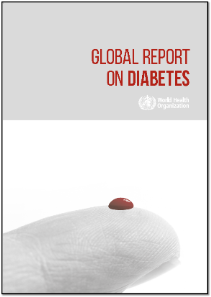- 电话:+1 2027805918 传真:+1 208640718 邮箱:info@seedoctorsinusa.com 国内电话:400-7800-120
- Copyright © 2014 - 2017 Z&L International Medical(Z&L) All Rights Reserved.
- SeeDoctorsInUSA 美国好大夫(美国好医生)operated by Z&L International Medical, LLC | Technical Support by Jing
“Beat Diabetes ”今年的世界卫生组织日主题

4月7日是世界卫生日,今年的主题定为“应对糖尿病”。
On the occasion of World Health Day 2016, WHO issues a call for action on diabetes, drawing attention to the need to step up prevention and treatment of the disease.
The first WHO Global report on diabetes demonstrates that the number of adults living with diabetes has almost quadrupled since 1980 to 422 million adults. Factors driving this dramatic rise include overweight and obesity.
In 2012 alone diabetes caused 1.5 million deaths. Its complications can lead to heart attack, stroke, blindness, kidney failure and lower limb amputation.
The new report calls upon governments to ensure that people are able to make healthy choices and that health systems are able to diagnose, treat and care for people with diabetes. It encourages us all as individuals to eat healthily, be physically active, and avoid excessive weight gain.
目前,我们不得不面对的一个事实是:中国已经成为糖尿病大国!除了种群遗传因素外,饮食和生活习惯也是一个重要原因
“吃得多”、“吃得好”、“吃得精”,中国现代生活的的三吃生活,也是造成糖尿病在人群中“流行”的原因。大部分人缺乏有效的运动, 久坐不动也促进了糖尿病的发展。

据2013年权威部门发布的调查报告显示:中国成年人糖尿病患病率为11.6%,处于糖尿病前期的人占总人口的50.1%。也就是说,不到10个成年人中,就有一个糖尿病患者;每两个成年人中,就有一个属于糖尿病前期。根据这项开展于2010年的调查,我国糖尿病患病率超过美国(11.3%),患者人数达1.14亿,超过印度,成为了名符其实的糖尿病第一大国。
1、“节俭基因”学说
1960年代,美国遗传学家尼尔首次提出“节俭基因”学说。他认为,人类祖先曾长期生活在食物匮乏中,生产力低下与人口过度繁殖导致饥荒频发。因此,那些具有“节俭”适应性的能力、可以最大限度地将食物转化为脂肪储存在体内的人,才能更容易生存下来。而这些具有“节俭基因”的人,原本是自然进化的胜出者,却在稳定富足的现代社会,因更易囤积脂肪而患上糖尿病。尼尔教授的“节俭基因”说,从另一个角度解释了中国人现在的糖尿病高发率。原来这部分人群,基本都经历了上个世纪五六十年代的饥荒时代,而现在的生活却是如此稳定富足。能够佐证尼尔教授的“节俭基因”假说的案例还出现在瑙鲁。贫穷而又勤劳的岛民祖先把“节俭基因”一代代传给瑙鲁人,当外来的西方生活方式被带进岛上的时候,瑙鲁人身体里的这种基因一时无法适应突然降临的富足生活。而欧洲人则由于早已习惯了现代生活方式,节俭基因在他们体内已逐步消失,所以同样的生活环境并没有给他们带来更多的糖尿病。
2、“荷兰饥荒研究”
1998年,《柳叶刀》杂志发表了糖尿病领域著名的“荷兰饥荒研究”。
这项研究结果表明:在1944-1945年饥荒时在妈妈肚子里挨饿出生的荷兰人与之后一年食品供应正常时出生的孩子相比,成年后更易发胖,并伴有胰岛素抵抗和餐后血糖升高。
3、我国的三年大饥荒等研究
“遭遇中国大饥荒的婴幼儿成年糖尿病风险增加”,这个结论是2010年中国疾控中心的马冠生等人得出的,同时发表在2010年的《糖尿病》杂志上。马冠生他们通过2002年中国国家营养和健康横断面调查,找到了1954-1964年出生的农村受试者7874人,结果发现,遭遇过1959-1961年三年中国大饥荒的胎儿与儿童,成年后患高血糖症与糖尿病的风险增加,其中,又以后来营养过剩者更甚。同样,哈佛大学教授胡丙长也主持了一项同样针对中国三年大饥荒年代胎儿的研究,结果明确表示,胎儿时期严重的饥荒与成年后高血糖的发生风险有明显的相关性,而且,越是成年以后饮食习惯西方化和经济条件好的人,这种联系越强烈。早年饥荒因素的影响,或许也是中国人没有美国人那么胖,却拥有更高的糖尿病患病率的原因。
现在,糖尿病人应该明白为什么自己和身边的人越来越多的人成为糖尿病人,甚至爆发出了不少的“小糖人”。
在中国,曾经被称为“成年型”的2型糖尿病近年来有年轻化、低龄化、几何级化发展的趋势。
那些胃口好又有糖尿病家族史的“小胖墩”已经逐渐成为抢占成年糖尿病“地盘”的主力。
细想中国糖友幼年化现象,一是也许和节俭基因有关,再者就是中国经济发展以及国人肆意饮食不加节制的后果。
生活可口可乐化:
在祖父辈生活中没有可口可乐等碳酸带气饮料的年代,温饱也成问题,那个时候糖尿病三个字对于整个国人都是遥远的事情。但今天,从婴幼儿开始,解渴这件简单的事情,有太多机会被可口可乐、雪碧等代替了我们原来“甜蜜的井水”。等成年工作以后,不是快速以鸡腿堡等各种快餐而解决,就是常常出入高档酒店开会、吃饭,将满桌的珍馐佳肴收入肚中。这样的生活,谁都无法抵挡。
“吃得多”、“吃得好”、“吃得精”,中国现代生活的的三吃生活,也是造成糖尿病在人群中“流行”的原因。
久坐不动的一代:科技的发展、经济的提升,带给中国人的不但是饮食结构的改变,也是出行方式的改变。中国人无论男女老幼都普遍开始享受家庭小汽车带来的舒适和便捷,不知不觉间,就给人体带来了改变。据统计,一位男性在拥有小汽车以后,体重将平均增加1.8公斤,达到肥胖标准的可能性将增加一倍,而中国的小胖子比例已经是几十年前的好几倍了。工作环境加上交通工具的变化,令中国中产阶级和白领阶层的体力活动明显减少,一个庞大的“久坐群体”的形成,是糖尿病广泛流行、发病年龄呈现年轻化趋势的重要因素。有调查显示看电视这件再平常不过的生活,也和糖尿病的多发密切相关。哈佛大学著名的“护士健康研究项目”发现,每天看电视两小时,可增加糖尿病的患病风险14%。分析认为,看电视是所有静坐活动中健康风险最高的一种,原因可能是看电视的过程中人们往往很容易吃东西、喝饮料。
“在美国,是穷人得糖尿病的多;在中国,是富人更容易得糖尿病”,
但这里的“富人”要打引号。美国的有钱人注意饮食健康,流行打理家务、去健身房锻炼,把身体练得精瘦,得糖尿病的自然就少。而经济状况较差的美国人为了省钱,吃便宜而高热量的食品,也没有钱去健身房锻炼,所以大胖子多,得高血压、冠心病、糖尿病的也就多。中国的中产阶级及以上的富人,正好在享受着美国穷人的生活方式,糖尿病的高发也就不言而喻了。
中国成年人中有一半人已经处于糖尿病前期。
“你想象一下,如果这些人未来全都转为糖尿病患者,那将会对中国的医疗体系带来多大的冲击?”糖尿病专家李光伟如此担忧的说。如果不加以控制,不是糖尿病前期的另一半成人或早或晚也会成为糖尿病前期。成为糖尿病前期以后如果不加以生活方式干预,大多数都有转变成糖尿病的风险。中国的下一代呢?如果不改变目前肆意的饮食习惯、继续久坐的生活方式,将会有更多的小胖子诞生,他们中的相当一部分人将变成糖尿病大军的一员。国人目前的生活方式已经和糖尿病的发生率高度切合,每一个中国人都有成为糖尿病的可能性。
对于糖尿病前期,世卫组织的诊疗指南并不推荐药物干预。唯一能够阻断他们继续演变成糖尿病的办法,就是生活方式干预,也就是当一个人拥有充分的食品和充分的运动时间时,要学会吃和运动。
World Health Day 2016: WHO calls for global action to halt rise in and improve care for people with diabetes
First WHO Global report on diabetes: 422 million adults live with diabetes, mainly in developing countries
6 April, 2016 | Geneva - The number of people living with diabetes has almost quadrupled since 1980 to 422 million adults, with most living in developing countries. Factors driving this dramatic rise include overweight and obesity, WHO announced ahead of World Health Day.
WHO is marking its annual World Health Day (7 April), which celebrates the Organization’s founding in 1948, by issuing a call for action on diabetes. In its first “Global report on diabetes”, WHO highlights the need to step up prevention and treatment of the disease.
Health-promoting environments reduce risk factors
Measures needed include expanding health-promoting environments to reduce diabetes risk factors, like physical inactivity and unhealthy diets, and strengthening national capacities to help people with diabetes receive the treatment and care they need to manage their conditions.
“If we are to make any headway in halting the rise in diabetes, we need to rethink our daily lives: to eat healthily, be physically active, and avoid excessive weight gain,” says Dr Margaret Chan, WHO Director-General. “Even in the poorest settings, governments must ensure that people are able to make these healthy choices and that health systems are able to diagnose and treat people with diabetes.”
Diabetes is a chronic, progressive noncommunicable disease (NCD) characterized by elevated levels of blood glucose (blood sugar). It occurs either when the pancreas does not produce enough of the insulin hormone, which regulates blood sugar, or when the body cannot effectively use the insulin it produces.
Key findings from WHO’s “Global report on diabetes”
Among the key findings from the “Global report on diabetes” are:
- The number of people living with diabetes and its prevalence are growing in all regions of the world. In 2014, 422 million adults (or 8.5% of the population) had diabetes, compared with 108 million (4.7%) in 1980.
- The epidemic of diabetes has major health and socioeconomic impacts, especially in developing countries.
- In 2014, more than 1 in 3 adults aged over 18 years were overweight and more than one in 10 were obese.
- The complications of diabetes can lead to heart attack, stroke, blindness, kidney failure and lower limb amputation. For example, rates of lower limb amputation are 10 to 20 times higher for people with diabetes.
- Diabetes caused 1.5 million deaths in 2012. Higher-than-optimal blood glucose caused an additional 2.2 million deaths by increasing the risks of cardiovascular and other diseases.
- Many of these deaths (43%) occur prematurely, before the age of 70 years, and are largely preventable through adoption of policies to create supportive environments for healthy lifestyles and better detection and treatment of the disease.
- Good management includes use of a small set of generic medicines; interventions to promote healthy lifestyles; patient education to facilitate self-care; and regular screening for early detection and treatment of complications.
Global commitments to reduce diabetes
“Many cases of diabetes can be prevented, and measures exist to detect and manage the condition, improving the odds that people with diabetes live long and healthy lives,” says Dr Oleg Chestnov, WHO’s Assistant Director-General for NCDs and Mental Health. “But change greatly depends on governments doing more, including by implementing global commitments to address diabetes and other NCDs.”
These include meeting Sustainable Development Goal (SDG) target 3.4, which calls for reducing premature death from NCDs, including diabetes, by 30% by 2030. Governments have also committed to achieving 4 time-bound national commitments set out in the 2014 UN General Assembly “Outcome Document on Noncommunicable Diseases”, and attaining the 9 global targets laid out in the WHO “Global Action Plan for the Prevention and Control of NCDs”, which include halting the rise in diabetes and obesity.
“Around 100 years after the insulin hormone was discovered, the “Global report on diabetes” shows that essential diabetes medicines and technologies, including insulin, needed for treatment are generally available in only 1 in 3 of the world’s poorest countries,” says Dr Etienne Krug, Director of WHO’s Department for the Management of NCDs, Disability, Violence and Injury Prevention. “Access to insulin is a matter of life or death for many people with diabetes. Improving access to insulin and NCD medicines in general should be a priority.”
Global efforts are underway to make medicines, including for NCDs, more available and affordable. Commitments from world leaders, including the SDGs, the 2011 “UN Political Declaration on the Prevention and Control of Noncommunicable Diseases”, the 2014 UN General Assembly “Outcome Document on Noncommunicable Diseases”, and the work of the UN Secretary-General’s high-level panel on access to essential medicines are aimed at improving affordability and availability of essential drugs for people living with diabetes.
